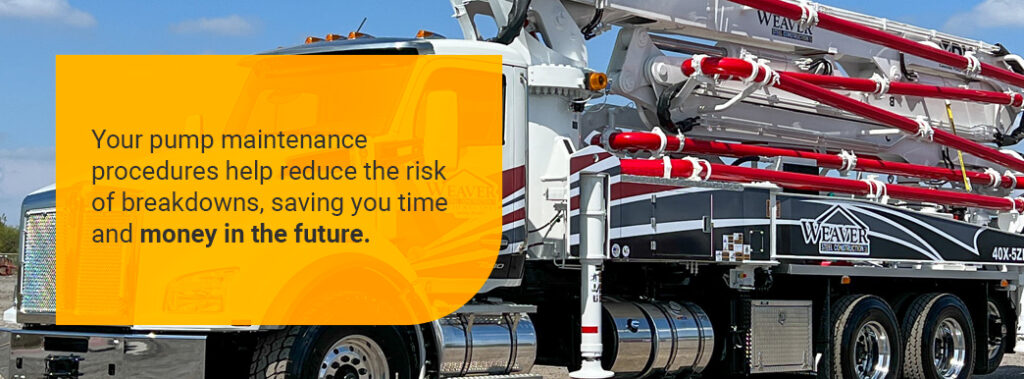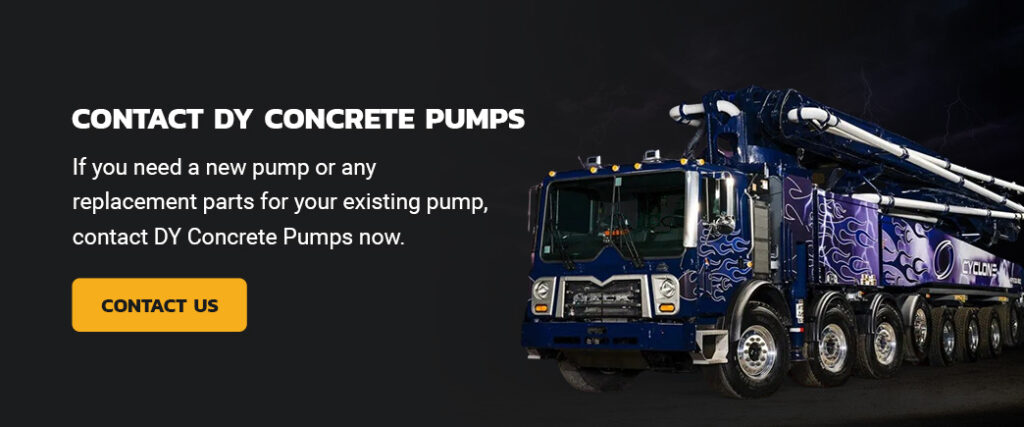Concrete Pump Maintenance Tips
Posted On: 02/01/2024 | Posted by: DY Concrete Pumps

A concrete pump can be an instrumental piece of equipment that easily delivers concrete when and where you need it for a construction job. Like any piece of equipment you use, the better you take care of it, the longer it will last, and the more effective it will be.
Once you develop a consistent boom pump maintenance schedule, you should have no problem executing the essential steps required to maximize your equipment. Here are some helpful concrete pump maintenance tips to get you started.
The Importance of Pump Maintenance Scheduling
Schedule routine inspections to keep your concrete pumps operating efficiently and safely. Your pump maintenance procedures help reduce the risk of breakdowns, saving you time and money in the future. Fewer emergencies and less downtime mean a safer, more reliable working environment.
While some pump owners might only address repairs when they come up, preventive maintenance is a more sustainable approach. Establishing a regular pump maintenance schedule safeguards your equipment investment and ensures its prolonged durability, allowing you to counter repairs before they need your attention.
For construction companies, scheduling regular maintenance becomes a critical practice. It guarantees that your concrete pump continues to receive the care it needs, even during your busiest times. You want to ensure your construction projects receive all the benefits of concrete pumps for as long as possible.

Concrete Pump Maintenance Checklist
Your concrete pump preventive maintenance checklist should include the following tasks.
Every Day
By diligently following this everyday maintenance checklist, you’ll prolong the life span of your concrete pump and ensure it operates at peak performance. At the end of each day or after an eight-hour shift:
- Lubricate the rear portion of the pump.
- Examine the oil level.
- Assess the tension of the gas in the accumulator.
- Ensure the wash box is free of grout and drain the water.
- Substitute any blown fuses.
- Verify the levels of diesel, oil, power steering fluid, radiator fluid and tire condition in the truck.
Every Week
By conducting maintenance every week or 40 hours of use, you greatly reduce the risk of unexpected breakdowns during crucial project phases. Here’s what to do weekly:
- Inspect the grease pod.
- Verify oil levels within the pump and water levels in the wash box.
- Confirm that the boom filter gauges are indicated in green.
- Ensure all prop switches function properly.
- Examine the truck’s alternator, lug nuts and belts.

Every Three Weeks
While daily and weekly checks focus on immediate operational needs, a three-week maintenance inspection is more in-depth. It allows for a comprehensive assessment of the concrete pump’s condition. This level of scrutiny helps identify underlying issues that may have gone unnoticed during shorter intervals.
Every three weeks or after about 100 hours of use, do the following:
- Thoroughly lubricate the entire boom, ensuring the turret receives just the right amount of grease, avoiding over- or under-greasing.
- Conduct a visual inspection for any signs of damaged gaskets or leaks along the boom structure.
- Carefully examine all hydraulic hoses for indicators such as bubbling, dry-rotting, cracking or abrasion that could lead to leaks or inefficiencies.
- Inspect the switchover cylinders to ensure they work properly and are free of defects.
- Check the pretension on the cutting ring, guaranteeing it’s adjusted correctly for optimal performance.
- Scrutinize the truck’s brake pads and air lines and assess the tension on the belts for signs of wear or damage.
- Perform a brake test by pressurizing the truck to 100 PSI, shutting it off and pressing the gauge until the switch pops out to verify their functionality at low pressures.
- Ensure all bolts securing the truck to its frame are securely tightened to maintain structural integrity.
Every Six Weeks
Every six weeks or after about 250 hours of use, you should:
- Perform an oil change in the boom pump to ensure continued lubrication and optimal performance.
- Consider repacking the differential cylinders if any signs of oil leakage are detected.
- Conduct a thorough inspection of the water tank to identify wear, fatigue or potential issues.
- Check for leaks and ensure the water levels in the wash box are adequate for efficient cleaning operations.
- Replace both the boom and primary tank filters to maintain filtration efficiency.
- Examine the boom hand valves for any signs of leaks and inspect the end caps of the coils for rust.
- Inspect the blowout hose for indications of dry-rotting, cracking or any other potential problems.
- Look for leaks in the outriggers, ensuring their integrity for stable operations.
- Assess the pretension on the outrigger chain to maintain stability during the process.
- Check and adjust the pretension on the cutting ring for optimal concrete flow.
- Verify the compression seal inside the cutting ring is intact to prevent potential leaks.
- Conduct a comprehensive inspection of the wireless control system to ensure reliable remote operation.
- Inspect the hard-line box to confirm all components are in good working condition and well-maintained.
Additionally, it is crucial to perform preventive maintenance on the truck:
- Change all the truck filters and dump the fluids.
- Check the shift tower.
- Inspect the belts thoroughly.
- Check the exhaust pipe system, including the turbocharger and muffler.
- Grease the transmission and check the fluid inside.
- Ensure there is no play in the output shaft.
- Make sure the universal joints and carrier bearing are in good shape.
- Check for oil in the first and second drive axles.
- Examine the air tanks, air lines and dryer.
- Inspect the clutch pretension.
- Check the radiator by blowing air from the engine to the radiator and back.
- Make sure the slack adjusters can move.
Every Three Months
The three-month/500-hour maintenance check allows for a more comprehensive assessment of your concrete pump. Over this extended period, wear and tear on various components may become more pronounced. By conducting this check, you comprehensively understand your equipment’s condition, including parts that might not need attention during shorter intervals.
Every three months or after about 500 hours of use:
- Conduct a thorough inspection of the entire boom.
- Examine the material cylinders for any issues.
- Verify that the turret possesses sufficient torque.
A complete pump inspection should carefully examine all elements. A professional can also check the pump’s maintenance to ensure proper lubrication and sufficient oil and water levels.
When to Replace Your Concrete Pump Truck
Like any vehicle, concrete pump trucks will need replacing as they age and wear over time. Knowing when to replace your truck with a new one helps you maintain operational efficiency, safety and competitiveness. Here are the telltale signs that indicate it might be time for an upgrade:
- Frequent and costly repairs: If your concrete pump truck is constantly in the shop for repairs and the costs are prohibitive, investing in a new truck may be more cost-effective.
- Reduced performance: As concrete pump trucks age, their performance can decline. You might notice a decrease in pumping capacity, longer setup times or reduced precision in concrete placement.
- Safety concerns: Safety should always be a top priority in the construction industry. If your older truck shows safety issues that can’t be adequately addressed through repairs, it’s time for a new one.
Contact DY Concrete Pumps
DY Concrete Pumps’ concrete pumps are meticulously engineered, considering owners’ and operators’ needs and preferences. When you choose a concrete pump from us, you’re not just acquiring a machine — you’re gaining access to over four decades of practical user insights backed by our industry-leading support and service network.
In addition to the above pump maintenance procedures, read the manufacturer-provided owner and safety manuals and follow any recommended maintenance suggestions. If you need a new pump or any replacement parts for your existing pump, contact DY Concrete Pumps now.


 1-844-397-8677
1-844-397-8677



